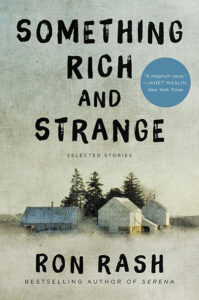Something Rich and Strange

By Ron Rash
448 pages
Published Nov. 4, 2014
This is one of two short story collections The Mules read for our February meeting. It was the second book of short stories we read by Ron Rash, who is indisputably one of the finest American short story crafters writing today.
In Something Rich and Strange, he gives us 32 different sorts of stories about different kinds of people, presented in different lengths, tempos, and points of view. The rugged hills and farms and valleys of Appalachia provide a rich and strange background for the rich and strange vignettes of the characters that come to life in each one.
What I Liked About It
Ron Rash is a specialist in writing short stories, which takes a very different set of skills than writing novels. He is a literary writer, who, like Cormac McCarthy or William Faulkner, can not only tell a tense and compelling story but can do so with a mastery of phrasing and diction and dialog that provides its own rewards.
Critical Reception
* “Ron Rash occupies an odd place in the pantheon of great American writers, and you’d better believe he belongs there… Something Rich and Strange is a major short-story anthology that can introduce new readers to this author’s haunting talents and reaffirm what his established following already knows.” (New York Times)
* “No one writes better about the misunderstood, bedeviled, mule-stubborn inhabitants of Southern Appalachia than Rash… Something Rich and Strange is a bonanza for short-story fans, and another great introduction to Rash for those who haven’t read the originals yet.” (Atlanta Journal-Constitution)
* “The prose in every story is sensual and expressive. [Rash] swings easily between humor and pathos, the mundane and the momentous.” (Chicago Tribune)
Chick Lit: The Introduction of a New Fiction Genre 30 Years Ago

Helen Fielding
On February 28, 1995, an anonymous column appeared in the British newspaper The Independent, titled “The Diary of Bridget Jones.” The idea for the column came from Charlie Leadbeater, the features editor. According to This Week in Literary History, Leadbeater “had been looking for a writer to capture a certain voice, to speak to the kind of women he saw at work every day. It was his wife who suggested Helen Fielding, who wrote for The Independent on Sunday.”
Fielding was working on what she called “an earnest and frankly unreadable novel about cultural divides in the Caribbean” when she was invited to write the column. “But,” she said, “to write a column, as myself, about single life in London. Much as I needed the money, the idea of writing about myself in that way seemed hopelessly embarrassing and revealing. I offered to write it anonymously, as an exaggerated, comic, fictional character. I assumed no one would read it, and it would be dropped after six weeks for being too silly.”
At first, Fielding didn’t tell anyone at the paper what she was doing. “I was working alongside a lot of very clever, seasoned journalists who were writing about New Labour and Chechnya and I felt stupid writing about calories and alcohol units and why it takes three hours between waking up and leaving the house in the morning,” she later wrote. “When we started getting letters praising the column, I started boasting, ‘It’s by me, meeeee!’ and things snowballed from there.”
The Diary of Bridget Jones became a hugely bestselling novel, an Academy Award-winning movie, and arguably the model for a new genre of fiction that became known as “chick lit.”
If you’d like to know more about this story and the continuing controversy about its standing in the hierarchy of contemporary British literature, here is a link to an essay on the subject.
 MarkFord
MarkFord